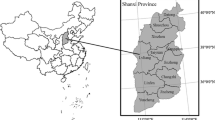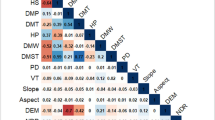Abstract
Prediction of forest fire ignition may aid in forest fire vigilance and monitoring, and in prioritizing forest fuel treatments. In this paper, we chose easily obtained spatial variables pertaining to topography, vegetation types, meteorological conditions, climate, and human activity to predict forest fire ignition in Heilongjiang province, China, using logistic regression. Results showed fire ignition prediction through logistic regression had good accuracy. Climatic variables (e.g., average annual mean temperature and precipitation) and meteorological conditions (e.g., daily minimum temperature, daily minimum humidity, daily mean humidity, and mean wind speed) are the main determinants of natural forest fires. In the case of anthropogenic fires, vegetation types and human activity as indicated by distances to roads and settlements combined with suitable meteorological conditions (e.g., daily mean humidity) are the main driving factors. The fire ignition probability map can be easily used to prioritize areas for vigilance, to make decisions on allocating firefighting resources, and to select vulnerable spots for forest fuel treatments. It was found that forest fuel treatments should be focused on the Great Xing’an Mountains.





Similar content being viewed by others
References
Avila-Flores D, Pompa-Garcia M, Antonio-Nemiga X, Rodriguez-Trejo D, Vargas-Perez E, Santillan-Perez J (2010) Driving factors for forest fire occurrence in Durango State of Mexico: a geospatial perspective. Chin Geo Sci 20:491–497
Carmo M, Moreira F, Casimiro P, Vaz P (2011) Land use and topography influences on wildfire occurrence in northern Portugal. Landsc Urban Plan 100:169–176
Catry FX, Rego FC, Bação FL, Moreira F (2009) Modeling and mapping wildfire ignition risk in Portugal. Int J Wildland Fire 18:921–931
Chang Y, He HS, Bishop I, Hu Y, Bu R, Xu C, Li X (2007) Long-term forest landscape responses to fire exclusion in the Great Xing’an Mountains, China. Int J Wildland Fire 16:34–44
Chang Y, He HS, Hu Y, Bu R, Li X (2008) Historic and current fire regimes in the Great Xing’an Mountains, northeastern China: implications for long-term forest management. For Ecol Manag 254:445–453
Chuvieco E, González I, Verdú F, Aguado I, Yebra M (2009) Prediction of fire occurrence from live fuel moisture content measurements in a Mediterranean ecosystem. Int J Wildland Fire 18:430–441
de la Riva J, Perez-Cabello F, Lana-Renault N, Koutsias N (2004) Mapping wildfire occurrence at regional scale. Remote Sens Environ 92:363–369
de Vasconcelos MJP, Silva S, Tome M, Alvim M, Pereira J (2001) Spatial prediction of fire ignition probabilities: comparing logistic regression and neural networks. Photogramm Eng Remote Sens 67:73–81
del Hoyo VL, Martín Isabel M, Martínez Vega F (2011) Logistic regression models for human-caused wildfire risk estimation: analysing the effect of the spatial accuracy in fire occurrence data. Eur J For Res 130:983–996
Deng XW, Wen DY, Deng SW (2003) A preliminary study of the relationship between forest fire and landscape pattern. Fire Saf Sci 12:238–244 (in Chinese)
Di LY, Sun RY (2007) Summarization of research on forest fire in China. J Catastrophol 4:118–123 (in Chinese)
Díaz-Delgado R, Lloret F, Pons X (2004) Spatial patterns of fire occurrence in Catalonia, NE, Spain. Landsc Ecol 19:731–745
Dickson BG, Prather JW, Xu Y, Hampton HM, Aumack EN, Sisk TD (2006) Mapping the probability of large fire occurrence in northern Arizona, USA. Landsc Ecol 21:747–762
Dlamini WM (2010) A Bayesian belief network analysis of factors influencing wildfire occurrence in Swaziland. Environ Model Soft 25:199–208
Fielding AH, Bell JF (1997) A review of methods for the assessment of prediction errors in conservation presence/absence models. Environ Conserv 24:38–49
Finney MA (2007) A computational method for optimising fuel treatment locations. Int J Wildland Fire 16:702–711
Garcia CV, Woodard P, Titus S, Adamowicz W, Lee B (1995) A logit model for predicting the daily occurrence of human caused forest-fires. Int J Wildland Fire 5:101–111
Hein S, Weiskittel A (2010) Cutpoint analysis for models with binary outcomes: a case study on branch mortality. Eur J For Res 129:585–590
Hering AS, Bell CL, Genton MG (2009) Modeling spatio-temporal wildfire ignition point patterns. Environ Ecol Stat 16:225–250
Hosmer DW, Lemeshow S (2000) Applied logistic regression. Wiley, New York
Hosmer DW, Hosmer T, Le Cessie S, Lemeshow S (1997) A comparison of goodness-of-fit tests for the logistic regression model. Stat Med 16:965–980
Hu H, Jin S (2002) Study on forest fire regime of Heilongjiang province II. Analysis on factors affecting fire dynamics and distributions. Scientia Silvae Sinicae 38:98–102 (in Chinese)
Jiménez-Valverde A (2012) Insights into the area under the receiver operating characteristic curve (AUC) as a discrimination measure in species distribution modelling. Glob Ecol Biogeogr 21:498–507
Koutsias N, Kalabokidis KD, Allg wer B (2004) Fire occurrence patterns at landscape level: beyond positional accuracy of ignition points with kernel density estimation methods. Nat Resour Model 17:359–375
Legendre P, Legendre L (1998) Numerical ecology. Elsevier, Amsterdam
Liu Z, Yang J, Chang Y, Weisberg PJ, He HS (2012) Spatial patterns and drivers of fire occurrence and its future trend under climate change in a boreal forest of Northeast China. Glob Change Biol 18:2041–2056
Lozano FJ, Suárez-Seoane S, de Luis E (2007) Assessment of several spectral indices derived from multi-temporal landsat data for fire occurrence probability modelling. Remote Sens Environ 107:533–544
Lozano FJ, Suarez-Seoane S, Kelly M, Luis E (2008) A multi-scale approach for modeling fire occurrence probability using satellite data and classification trees: a case study in a mountainous Mediterranean region. Remote Sens Environ 112:708–719
Maingi JK, Henry MC (2007) Factors influencing wildfire occurrence and distribution in eastern Kentucky, USA. Int J Wildland Fire 16:23–33
Martell DL, Otukol S, Stocks BJ (1987) A logistic model for predicting daily people-caused forest fire occurrence in Ontario. Can J For Res 17:394–401
Oliveira S, Oehler F, San-Miguel-Ayanz J, Camia A, Pereira JMC (2012) Modeling spatial patterns of fire occurrence in Mediterranean Europe using Multiple Regression and Random Forest. For Ecol Manag 275:117–129
Padilla M, Vega-García C (2011) On the comparative importance of fire danger rating indices and their integration with spatial and temporal variables for predicting daily human-caused fire occurrences in Spain. Int J Wildland Fire 20:46–58
Phillips SJ, Elith J (2010) POC plots: calibrating species distribution models with presence-only data. Ecology 91:2476–2484
Podur J, Martell DL, Csillag F (2003) Spatial patterns of lightning-caused forest fires in Ontario, 1976–1998. Ecol Model 164:1–20
Preisler HK, Westerling AL, Gebert KM, Munoz-Arriola F, Holmes TP (2011) Spatially explicit forecasts of large wildland fire probability and suppression costs for California. Int J Wildland Fire 20:508–517
Puri K, Areendran G, Raj K, Mazumdar S, Joshi P (2011) Forest fire risk assessment in parts of Northeast India using geospatial tools. J For Res 22:641–647
Sağlam B, Bilgili E, Durmaz BD, Kadıoğulları Aİ, Küçük Ö (2008) Spatio-temporal analysis of forest fire risk and danger using landsat imagery. Sensors 8:3970–3987
Shu L, Tian X (1999) The research and application of the sustainable management technique of Forest Fuel. Fire Saf Sci 8:18–24 (in Chinese)
Swets JA (1988) Measuring the accuracy of diagnostic systems. Science 240:1285–1293
Vilar L, Woolford DG, Martell DL, Martín MP (2010) A model for predicting human-caused wildfire occurrence in the region of Madrid, Spain. Int J Wildland Fire 19:325–337
Wei Y, Rideout D, Kirsch A (2008) An optimization model for locating fuel treatments across a landscape to reduce expected fire losses. Can J For Res 38:868–877
Xu H (1998) Da Hinggan Ling Mountains forests in China. In. Scientific Press, Beijing (in Chinese)
Yang J, He HS, Shifley SR, Gustafson EJ (2007) Spatial patterns of modern period human-caused fire occurrence in the Missouri Ozark Highlands. For Sci 53:1–15
Zhao FJ, Shu LF (2007) The effects of abnormal climate on forest fire occurrence. For Fire Prevent 1:21–23 (in Chinese)
Zhou Y (1991) Vegetation of Greater Xingan in China. Scientific Press, Beijing (in Chinese)
Acknowledgments
This research was supported by The National Natural Science Foundation of China (Grant No. 31070422, 41201185, 41271201), and the Strategic Priority Research Program-Climate Change: Carbon Budget and Related Issues of the Chinese Academy of Sciences (Grant No. XDA05050201). We thank the Chinese Forestry Science Data Center (http://www.cfsdc.org/) for providing fire record data, and the China Meteorological Data sharing Service System (http://cdc.cma.gov.cn/) for providing observational meteorological data. DEM data were provided by the International Scientific & Technical Data Mirror Site, Computer Network Information Center, Chinese Academy of Sciences (http://datamirror.csdb.cn). We thank the anonymous reviewers for helpful suggestions that improved the manuscript.
Author information
Authors and Affiliations
Corresponding author
Rights and permissions
About this article
Cite this article
Chang, Y., Zhu, Z., Bu, R. et al. Predicting fire occurrence patterns with logistic regression in Heilongjiang Province, China. Landscape Ecol 28, 1989–2004 (2013). https://doi.org/10.1007/s10980-013-9935-4
Received:
Accepted:
Published:
Issue Date:
DOI: https://doi.org/10.1007/s10980-013-9935-4




